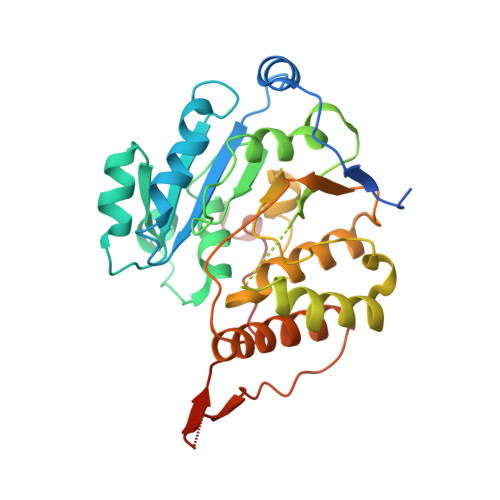A Native Ternary Complex Trapped in a Crystal Reveals the Catalytic Mechanism of a Retaining Glycosyltransferase.
Albesa-Jove, D., Mendoza, F., Rodrigo-Unzueta, A., Gomollon-Bel, F., Cifuente, J.O., Urresti, S., Comino, N., Gomez, H., Romero-Garcia, J., Lluch, J.M., Sancho-Vaello, E., Biarnes, X., Planas, A., Merino, P., Masgrau, L., Guerin, M.E.(2015) Angew Chem Int Ed Engl 54: 9898-9902
- PubMed: 26136334
- DOI: https://doi.org/10.1002/anie.201504617
- Primary Citation of Related Structures:
4Y6N, 4Y6U, 4Y7F, 4Y7G, 4Y9X - PubMed Abstract:
Glycosyltransferases (GTs) comprise a prominent family of enzymes that play critical roles in a variety of cellular processes, including cell signaling, cell development, and host-pathogen interactions. Glycosyl transfer can proceed with either inversion or retention of the anomeric configuration with respect to the reaction substrates and products. The elucidation of the catalytic mechanism of retaining GTs remains a major challenge. A native ternary complex of a GT in a productive mode for catalysis is reported, that of the retaining glucosyl-3-phosphoglycerate synthase GpgS from M. tuberculosis in the presence of the sugar donor UDP-Glc, the acceptor substrate phosphoglycerate, and the divalent cation cofactor. Through a combination of structural, chemical, enzymatic, molecular dynamics, and quantum-mechanics/molecular-mechanics (QM/MM) calculations, the catalytic mechanism was unraveled, thereby providing a strong experimental support for a front-side substrate-assisted SN i-type reaction.
- Unidad de Biofísica, Consejo Superior de Investigaciones Científicas - Universidad del País Vasco/Euskal Herriko Unibertsitatea (CSIC-UPV/EHU) and Departamento de Bioquímica, Universidad del País Vasco, 48940 Leioa, Bizkaia (Spain).
Organizational Affiliation:




















